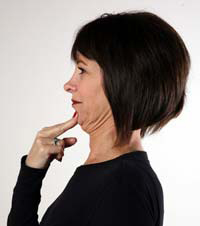What do I mean by this?
I feel that the best way to physically prepare for retirement is to actively
participate in how your body is aging.
I like to say that the solutions to most problems are
simple. Simple does not always mean easy. It takes effort. The simple part
should be preforming the exercises. The hard part is developing the focus to
preform them correctly every day. (Or at least 5 to 6 times per week.) The good
news is once you can do them correctly, it takes a lot less effort to maintain
the ability than it did to obtain it.
Having worked with clients up to 95 years of age, I have
made sure to observe what changes have occurred to their physical condition.
Today’s topic is the first post of
the area that can change the most, our posture. (Part 1 Head and Neck) What changes in our posture during
the decades from reaching adulthood until retirement?
 |
| Just because it is normal doesn't mean it has to happen to you. |
I believe that all training
should begin by improving a client’s posture before working on more complex
things like mobility and strength. Bad posture with a lack of mobility and
stability can lead to injury.
Improving your posture will also lead to less chance of losing your balance and falling. The farther your head is in front of your shoulders, the more likely you are to fall forward.
When I mention posture do you think of your body being held
in a rigid and static position? After reading my blog posts about this, I hope your
picture of posture will change. While it is important to be able to put your
body into a certain position, posture can be thought of as more dynamic than
that.
What causes changes in posture? Whatever position(s) we
spend the most time in has a huge effect on posture. An example is sitting down
watching TV or working on a computer or tablet. My mentor Vern Gambetta likes to say "gravity
never rest." Gravity is always trying to pull you down.

I like to say that posture begins at the top of your
head. In order to improve posture, work on exercises that counter the forward
head posture. WHEN WORKING ON ANY EXERCISE INVOLVING
YOUR SPINE, NEVER FORCE YOUR BODY INTO A POSITION. The focus
should always be on how you are controlling the muscles and joints and the
movements they are controlling.
The
pace of each movement should be slow. Perform from 5 to 10 reps of each. The
goal is to get the muscles turned on as opposed to tiring them out. If you feel
fatigue in the muscle when you are done, you have done too many. What exercises you perform is important.
How you perform them is more important.
Before
attempting any of the following exercises be sure to get the approval of your
Physician. Especially if you have ever had neck pain or a neck injury. If you
aren’t sure how to perform any of these exercises, have someone who knows how to teach them show you how to do them.
After evaluating that a new client should and can work on
their neck mobility, I begin teaching each client the following:
Neck Mobility (Since it is easier to focus
on what I want them to learn, I usually begin with my client in a seated position
and move to a standing position as soon as I feel they are ready. The standing
position takes more balance and control of the torso.

*
Flexion/Extension - Tuck your chin into your chest, and then lift your chin
upward as far as possible. Keep your torso as still as possible.

* Lateral
Flexion - lower your left ear toward your left shoulder and then your right ear
to your right shoulder. Focus on keeping your shoulders down.

* Rotation -
Turn your chin laterally toward your left shoulder and then rotate it toward
your right shoulder. Keep your torso as still as possible.

* Chin Tucking
– With chin slightly down, put a couple of fingers on chin. Slowly push chin
straight back. Hold for a count of 10 to 20.
These exercises are simple yet hardly anyone works on them. Including them in you daily routine will help keep your posture from becoming old. I really do believe it is that simple.
Next weeks topic (Part 2) will be Your
Shoulders and Thoracic Vertebrae

No comments:
Post a Comment